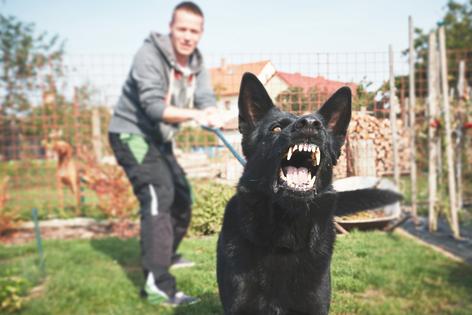My Pet World: Dog needs specialized training to overcome aggressive reactions to people
Dear Cathy,
I visited my son and daughter-in-law over the holidays. They have an eight-year-old rescued German Shepherd (GSD) mix that I had never met. In the past, she attacked a neighbor's dog, ripping its ear. When I met her, she gave me a fierce stare and growled. My daughter-in-law petted her and said, "It's all right, it's all right."
I had never experienced a dog stare like that (except once in a shelter when the dog was behind bars), but I knew it was trouble. The only thing I could think to do was to turn my body sideways from her, fold my arms, and look away. That calmed her — for the moment.
In the few days that I was there, she bit my son once and drew blood. We thought she wanted to bite me, but she was leashed and could not, so she bit him instead. Later, she managed to nip me, making red marks, but not breaking skin. They put her outside then, but she lunged and tried to bite me through the glass every time I walked past the patio doors. So, they isolated her in a spare room the rest of the time I was there.
I expressed my concern that this dog is dangerous and recommended they find a trainer specializing in aggressive dogs. Because she is very sweet and affectionate with my daughter-in-law, though, they nixed that idea.
What should people do to protect themselves from an aggressive dog? And can a dog like this ever be trained out of its aggression?
— E.F., Tucson, Arizona
Dear E.F.,
If a dog is that aggressive toward and in front of her family, it's definitely a reason to be concerned. Dogs can be overly protective of their families, but it's up to their families to manage those behaviors and ensure a dog is not a threat to someone’s safety.
That can be challenging for owners to do on their own, so specialized training is imperative. Her intense stare was a sign she viewed you as a threat, and you did the right things to calm her down. Also, your son and daughter-in-law were smart to put her in another room during your visit. But if these behaviors are left unchecked, they will worsen, not improve, with time.
It's worth noting that communities are cracking down on owners with aggressive dogs, from high fines to jail time, depending on what the dog has done. So, it’s important that your family find a trainer who specializes in training aggressive dogs.
A trainer will teach them positive and progressive behavior modification techniques to recondition her reactions to people. For example, this dog should never walk on a leash ahead of her owners, a position that only triggers protective behaviors. Instead, she should learn to heel on a leash right by her owner's side. It’s this specialized and individualized training that addresses the many things that can trigger an overprotective dog.
Reconditioning can take months, but it’s worth it to have a non-reactive dog. I recommend the training.
Dear Cathy,
I lost a cat a few years ago with a microchip but no collar. Why didn't my cat have a collar? You don't want them to be too tight, so the cat can't wriggle out of them if they get caught on something. But if I put them on the cat loose enough so that he can wriggle out of them if he needs to, the collar does not stay on the cat. He does figure out how to get it off, and in a few days, I find the collar on the floor. Please comment on how to fix this problem.
— Elizabeth, Garden City, New York
Dear Elizabeth,
While keeping a collar on a cat can be challenging, it's not impossible. According to a study by the American Veterinary Medical Association, 73% of the 538 cats they followed were still wearing collars six months later.
I highly recommend collars, even for indoor cats who could bolt out an open door. The added benefit of a collar and I.D. tag is that a cat is immediately identifiable as an owned pet, not a stray, so someone is likelier to pick up a cat to find their owner.
For those Houdini cats who wriggle out of their collars, use a breakaway collar and fit it so two fingers fit comfortably between collar and neck. This technique should help keep the collar on. The breakaway aspect of the collar will ensure her safety should the collar get hung up on something.
_____
_____
========
(Cathy M. Rosenthal is a longtime animal advocate, author, columnist and pet expert who has more than 25 years in the animal welfare field. Send your pet questions, stories and tips to cathy@petpundit.com. Please include your name, city, and state. You can follow her @cathymrosenthal.)
©2024 Tribune Content Agency, LLC.
(c) 2024 DISTRIBUTED BY TRIBUNE MEDIA SERVICES, INC.










